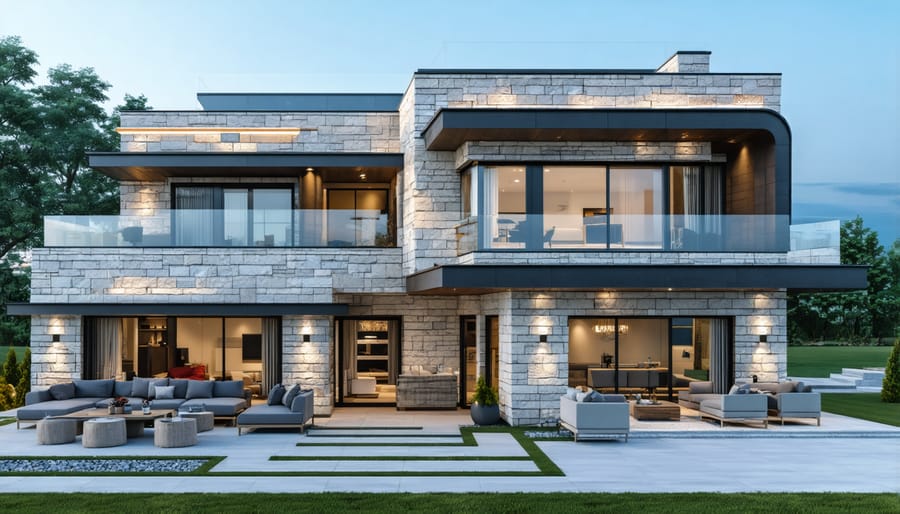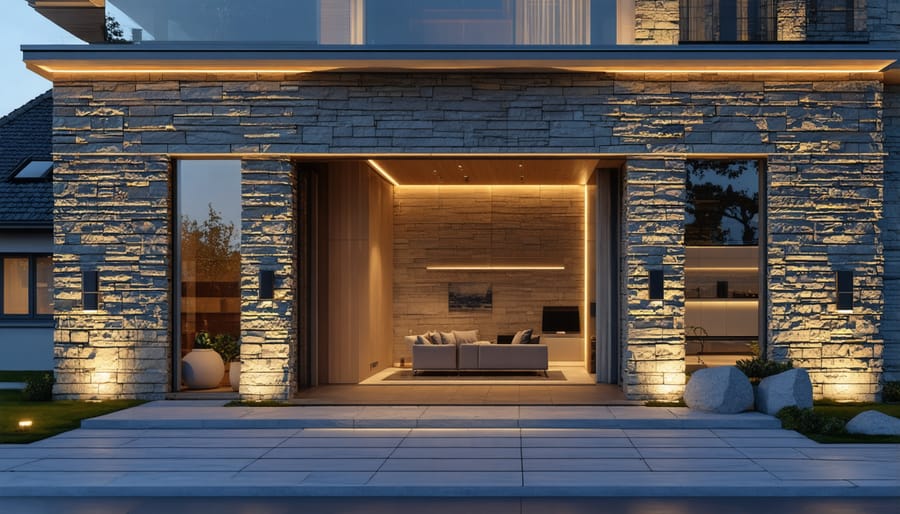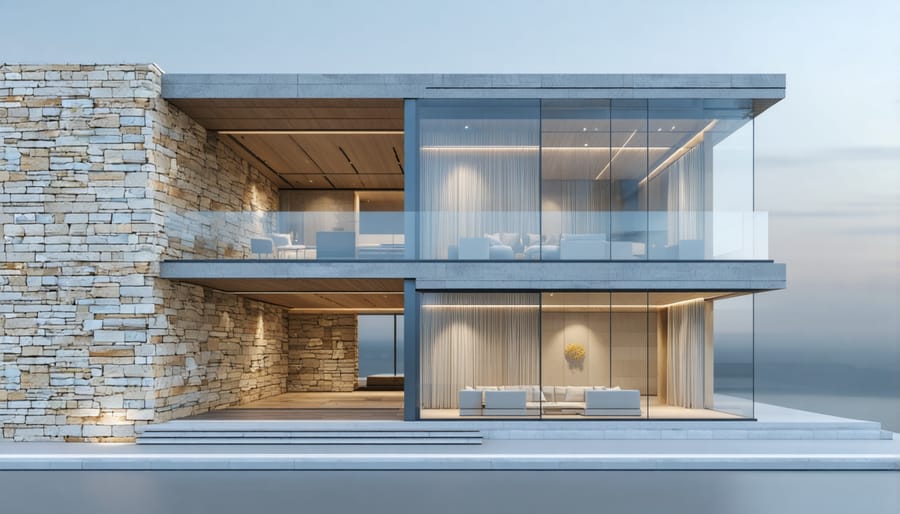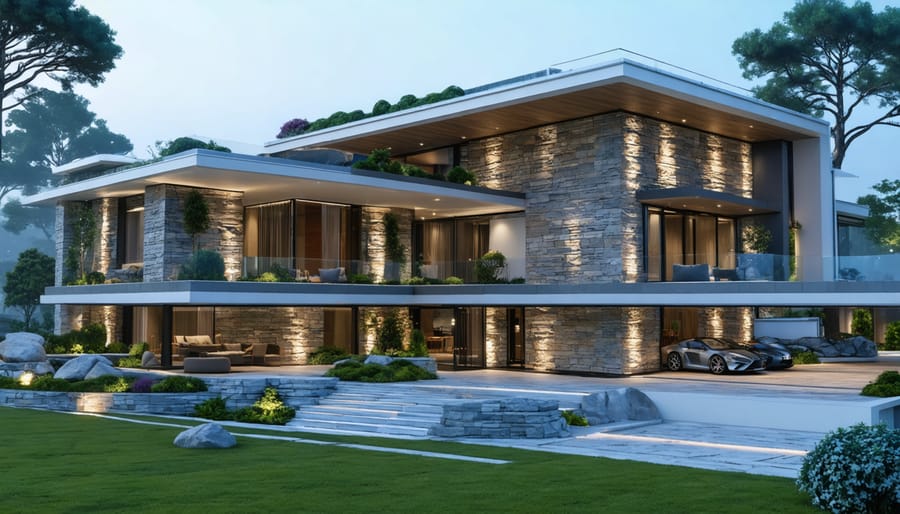Stone facades are revolutionizing residential architecture, transforming modern architecture through innovative materials and sustainable design practices. These timeless exterior finishes merge centuries-old craftsmanship with cutting-edge technology, offering homeowners unparalleled durability and sophisticated aesthetics.
Modern stone cladding systems have evolved far beyond traditional masonry, now incorporating advanced mounting technologies, engineered stone composites, and precision-cut natural stone panels that reduce installation time while maximizing structural integrity. From sleek limestone accents to dramatic slate walls, stone facades provide exceptional thermal performance, weather resistance, and minimal maintenance requirements – qualities that make them increasingly attractive to both architects and homeowners seeking long-term value.
As sustainable building practices gain prominence, stone facades stand out for their natural origins, energy efficiency, and remarkable longevity. These materials not only enhance a home’s curb appeal but also contribute to its environmental footprint reduction through superior insulation properties and locally-sourced options. Whether renovating a historic property or designing a contemporary masterpiece, stone facades offer versatile solutions that bridge the gap between architectural heritage and modern innovation.
Revolutionary Stone Facade Technologies
Ventilated Stone Cladding Systems
Ventilated stone cladding systems represent a significant advancement in facade technology, combining the timeless appeal of natural stone with modern performance benefits. This innovative system creates an air cavity between the building’s wall and the stone panels, allowing for continuous air circulation and improved thermal efficiency.
The system consists of three main components: the support structure, typically made of aluminum or stainless steel; the air cavity; and the stone panels mounted on the exterior. This configuration creates a chimney effect, where air flows freely behind the stone cladding, helping to regulate temperature and prevent moisture buildup.
Key advantages of ventilated stone facades include enhanced energy efficiency, superior moisture management, and improved acoustic insulation. During summer months, the air gap helps reduce heat gain, while in winter, it provides additional insulation. The system effectively manages rainwater and condensation, protecting the building’s structure from potential water damage.
Installation is typically faster compared to traditional stone cladding methods, as the panels are mechanically fixed to the support structure. This method also allows for easier maintenance and individual panel replacement when necessary. The system can accommodate various stone types and thicknesses, offering architects greater design flexibility while maintaining structural integrity.
For modern buildings seeking LEED certification or improved energy performance, ventilated stone cladding systems provide an excellent solution that combines sustainability with classical aesthetics.

Smart Stone Integration
Modern stone façades are evolving beyond their traditional aesthetic role to incorporate smart technology, creating dynamic and energy-efficient building exteriors. LED lighting systems integrated into stone cladding can transform buildings from static structures into interactive architectural elements that respond to their environment.
These smart stone integrations typically feature thin LED strips or panels installed behind translucent stone varieties, such as onyx or certain types of marble. The lighting can be programmed to create various effects, from subtle ambient illumination to dramatic color-changing displays that enhance the building’s nighttime presence.
Solar integration represents another innovative approach, with photovoltaic elements seamlessly incorporated into stone façade systems. These hybrid solutions maintain the natural beauty of stone while generating clean energy. Some manufacturers now offer stone panels with built-in solar cells that can power exterior lighting or contribute to the building’s overall energy needs.
Smart sensors embedded within stone façade systems can monitor structural integrity, temperature variations, and moisture levels. This data helps facility managers maintain optimal performance and predict maintenance needs before issues arise. Climate-responsive façade systems can automatically adjust internal building systems based on external conditions, improving energy efficiency.
The integration of these smart elements requires careful planning during the design phase to ensure proper wiring, weatherproofing, and long-term durability. While the initial investment may be higher than traditional stone façades, the benefits of enhanced functionality and energy savings make smart stone integration an increasingly popular choice for modern architecture.

Sustainable Stone Solutions
Thermal Performance Enhancement
Stone facades offer remarkable thermal performance benefits that contribute significantly to a building’s energy efficiency. When properly installed, these natural stone cladding systems create an effective thermal barrier, helping to regulate indoor temperatures throughout the year. Modern energy-efficient stone solutions can reduce heating and cooling costs by up to 30%.
The natural thermal mass of stone allows it to absorb heat during the day and release it slowly during cooler periods, creating a more stable indoor environment. This property, known as thermal inertia, helps minimize temperature fluctuations and reduces the load on HVAC systems. When combined with proper insulation materials and ventilation gaps, stone facades create an effective thermal envelope around the building.
Different stone types offer varying levels of thermal performance. For instance, granite and limestone possess excellent thermal retention properties, while marble provides moderate insulation capabilities. The thickness of the stone panels and the installation method also influence their thermal effectiveness. Modern rainscreen systems, which incorporate an air cavity between the stone facade and building wall, further enhance thermal performance by allowing for additional insulation and moisture control.
During summer months, stone facades help reflect solar radiation, while in winter, they can help retain indoor heat, contributing to year-round energy savings and improved comfort levels.
Environmental Impact
Modern stone facades have emerged as a cornerstone of sustainable stone design, offering significant environmental benefits when sourced and implemented responsibly. Natural stone’s durability means facades can last for centuries, reducing the need for replacement and minimizing waste. Unlike manufactured materials, stone requires minimal processing and produces lower carbon emissions during extraction and preparation.
Today’s stone facade installations often incorporate recycled materials and locally sourced stone, reducing transportation emissions and supporting regional economies. Advanced quarrying techniques have evolved to minimize environmental impact, while modern cutting methods reduce waste and maximize material efficiency. Many manufacturers now implement closed-loop water systems in processing facilities, significantly reducing water consumption.
The thermal mass properties of stone facades contribute to building energy efficiency by naturally regulating interior temperatures. This passive temperature control can lower heating and cooling costs by up to 25% in properly designed buildings. Additionally, stone facades are naturally fire-resistant and weather-resistant, eliminating the need for chemical treatments or toxic finishes.
Stone’s recyclability adds another layer of environmental benefit. When buildings are renovated or demolished, facade stones can be repurposed for other construction projects or crushed for use in aggregates, ensuring the material’s lifecycle continues beyond its initial application. This circular approach to construction materials helps reduce the industry’s environmental footprint while preserving natural resources for future generations.
Design Integration
Digital Design and Customization
In today’s architectural landscape, digital technology has revolutionized how we approach modern stone applications, particularly in facade design. Advanced 3D modeling software allows architects and designers to visualize stone facades with unprecedented precision, enabling them to experiment with different patterns, textures, and stone combinations before cutting a single piece.
Computer-aided design (CAD) and Building Information Modeling (BIM) systems have transformed the stone cutting process. These technologies enable precise measurements and custom specifications that guarantee perfect fits and minimal waste. CNC (Computer Numerical Control) machines translate digital designs into exact stone cuts, ensuring consistency across large facade projects while maintaining the natural beauty of each stone piece.
Digital templating has become particularly valuable for complex architectural features. Using laser scanning technology, designers can create exact digital replicas of existing structures, allowing new stone elements to be perfectly matched to historical buildings or integrated seamlessly with modern designs. This precision is especially crucial when working with curved surfaces or intricate geometric patterns.
Customization options have expanded dramatically with these digital tools. Architects can now design unique textures and surface treatments that would be impossible to achieve through traditional methods. 3D visualization tools allow clients to see exactly how different stone types will look in various lighting conditions and from different angles, making the selection process more informed and efficient.
The marriage of traditional stonework with digital technology has also improved installation efficiency. Digital planning tools can determine optimal panel sizes, joint locations, and anchoring systems, reducing on-site adjustments and ensuring structural integrity. This combination of ancient material and modern technology creates facades that are not only beautiful but also precisely engineered for longevity and performance.
Seamless Material Transitions
Modern stone facades achieve their most striking effects through thoughtful integration with other building materials. The key to successful material transitions lies in understanding how different elements complement and contrast with natural stone, creating visual harmony while maintaining functional integrity.
Glass serves as a natural counterpoint to stone, offering transparency and lightness that balances stone’s solidity. Large glass panels can create dramatic transitions between stone sections, allowing natural light to penetrate deeper into the building while establishing a dynamic interplay between opacity and transparency. This combination is particularly effective in contemporary designs where floor-to-ceiling windows meet textured stone surfaces.
Metal elements, whether aluminum, steel, or copper, provide another dimension to stone facades. These materials can serve as transitional elements, creating clean lines and defined boundaries between different facade sections. Brushed stainless steel or bronze accents can enhance the natural patterns and colors of stone while adding modern architectural detail. These combinations are particularly effective in commercial and high-end residential applications.
Wood introduces warmth and organic texture alongside stone, creating a natural partnership that speaks to biophilic design principles. Cedar, teak, or other weather-resistant woods can be used for accent walls, soffits, or decorative elements that soften the stone’s appearance while maintaining the facade’s natural character.
Successful material transitions require careful attention to detail in several areas:
– Joint design between different materials
– Weather sealing at material interfaces
– Thermal expansion considerations
– Color and texture coordination
– Scale and proportion balance
When properly executed, these material combinations can create sophisticated, layered facades that enhance both the aesthetic appeal and functional performance of the building envelope. The key is to ensure that each material transition serves both a practical and visual purpose, contributing to the overall architectural narrative while maintaining structural integrity.

Maintenance and Longevity
Stone facades are remarkably durable, often lasting for generations with proper maintenance. To ensure longevity, regular inspections should be conducted at least twice a year, particularly after severe weather events. During these inspections, look for signs of wear, loose stones, deteriorating mortar joints, or water damage.
Cleaning stone facades requires careful consideration of the stone type. Generally, a gentle cleaning approach using pH-neutral cleaners and soft-bristled brushes is recommended. Avoid high-pressure washing systems, which can damage mortar joints and erode softer stones. For stubborn stains, consult a stone restoration professional to prevent accidental damage from harsh chemicals.
Sealing is an essential maintenance step for many types of stone facades. Modern sealants provide excellent protection against moisture infiltration and environmental pollutants while maintaining the stone’s natural appearance. Depending on exposure levels and climate conditions, resealing may be necessary every 5-10 years.
Common maintenance tasks include:
– Repointing mortar joints when they show signs of deterioration
– Addressing any water drainage issues promptly
– Removing vegetation growth that could compromise the facade
– Repairing small cracks before they develop into larger problems
With proper care, stone facades can maintain their beauty and structural integrity for 100 years or more. The initial investment in quality materials and installation pays dividends through reduced long-term maintenance costs and enhanced property value. Modern installation techniques, including proper moisture barriers and ventilation systems, have significantly improved the longevity of stone facades compared to historical applications.
For properties in harsh climates, additional protective measures may be necessary. This might include extra waterproofing treatments or the installation of snow guards in regions with heavy snowfall. Regular professional assessments can help identify potential issues before they become serious problems, ensuring the facade’s continued performance and aesthetic appeal.
Innovative stone facades have revolutionized modern architecture, seamlessly blending timeless natural materials with cutting-edge technology. These advanced systems have transformed how we approach building design, offering enhanced sustainability through improved thermal performance and reduced environmental impact. The integration of smart technologies and automated installation methods has made stone facades more accessible and adaptable than ever before. As architects and designers continue to push boundaries, stone facades remain at the forefront of architectural innovation, proving that traditional materials can evolve to meet contemporary demands. The fusion of classical elegance with modern engineering has created buildings that are not only visually striking but also highly functional and sustainable, setting new standards for architectural excellence in the 21st century.










